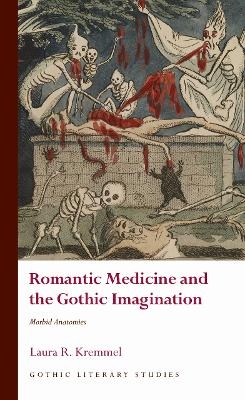
Romantic Medicine and the Gothic Imagination
Morbid Anatomies
Seiten
2022
University of Wales Press (Verlag)
978-1-78683-848-3 (ISBN)
University of Wales Press (Verlag)
978-1-78683-848-3 (ISBN)
This book demonstrates how Gothic literature experiments with and subverts Romantic medical debates to reassess the power of nonnormative bodies within medical, social and political spheres, and to reallocate narrative agency to bodies typically silenced.
This book debates a crossover between the Gothic and the medical imagination in the Romantic period. It explores the gore and uncertainty typical of medical experimentation, and expands the possibilities of medical theories in a speculative space by a focus on Gothic novels, short stories, poetry, drama and chapbooks. By comparing the Gothic's collection of unsavoury tropes to morbid anatomy's collection of diseased organs, the author argues that the Gothic's prioritisation of fear and gore gives it access to nonnormative bodies, reallocating medical and narrative agency to bodies considered otherwise powerless. Each chapter pairs a trope with a critical medical debate, granting silenced bodies power over their own narratives: the reanimated corpse confronts fears about vitalism; the skeleton exposes fears about pain; the unreliable corpse feeds on fears of dissection; the devil redirects fears about disability; the dangerous narrative manipulates fears of contagion and vaccination.
This book debates a crossover between the Gothic and the medical imagination in the Romantic period. It explores the gore and uncertainty typical of medical experimentation, and expands the possibilities of medical theories in a speculative space by a focus on Gothic novels, short stories, poetry, drama and chapbooks. By comparing the Gothic's collection of unsavoury tropes to morbid anatomy's collection of diseased organs, the author argues that the Gothic's prioritisation of fear and gore gives it access to nonnormative bodies, reallocating medical and narrative agency to bodies considered otherwise powerless. Each chapter pairs a trope with a critical medical debate, granting silenced bodies power over their own narratives: the reanimated corpse confronts fears about vitalism; the skeleton exposes fears about pain; the unreliable corpse feeds on fears of dissection; the devil redirects fears about disability; the dangerous narrative manipulates fears of contagion and vaccination.
Laura R. Kremmel is Assistant Professor of English in the Humanities Department at South Dakota School of Mines & Technology.
Acknowledgements
Introduction: The Laboratory of the Gothic Imagination
Chapter 1: Reanimated Corpses, Blood, and the Gothic Vital Element
Chapter 2: Anaesthetic Skeletons and the Pain of Melancholy
Chapter 3: Counterfeit Corpses and Evaded Dissection
Chapter 4: The Devil and the Disability Narrative
Chapter 5: Contagious Narratives and Gothic Vaccination
Conclusion
Notes
Bibliography
Index
| Erscheinungsdatum | 30.09.2021 |
|---|---|
| Reihe/Serie | Gothic Literary Studies |
| Zusatzinfo | No |
| Verlagsort | Wales |
| Sprache | englisch |
| Maße | 138 x 216 mm |
| Themenwelt | Literatur ► Klassiker / Moderne Klassiker |
| Geisteswissenschaften ► Sprach- / Literaturwissenschaft ► Anglistik / Amerikanistik | |
| Geisteswissenschaften ► Sprach- / Literaturwissenschaft ► Literaturwissenschaft | |
| Studium ► Querschnittsbereiche ► Geschichte / Ethik der Medizin | |
| Naturwissenschaften | |
| ISBN-10 | 1-78683-848-6 / 1786838486 |
| ISBN-13 | 978-1-78683-848-3 / 9781786838483 |
| Zustand | Neuware |
| Informationen gemäß Produktsicherheitsverordnung (GPSR) | |
| Haben Sie eine Frage zum Produkt? |
Mehr entdecken
aus dem Bereich
aus dem Bereich
Die Geschichte eines Weltzentrums der Medizin von 1710 bis zur …
Buch | Softcover (2021)
Lehmanns Media (Verlag)
CHF 27,90
Krankheitslehren, Irrwege, Behandlungsformen
Buch | Softcover (2024)
C.H.Beck (Verlag)
CHF 55,90


